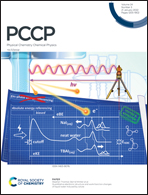Molecular insights into the electrowetting behavior of aqueous ionic liquids†
Abstract
Molecular dynamics (MD) simulations were applied to investigate the wettability of aqueous hydrophilic and hydrophobic imidazolium-based ionic liquid (IL) nano-droplets on a graphite surface under a perpendicular electric field. Imminent transformation in the droplet configuration was observed at E = 0.08 V Å−1 both for hydrophobic ILs 1-ethyl-3-methylimidazolium bis(trifluoromethylsulfonyl)imide [EMIM][NTF2] and SPC/E water droplets. However, for the hydrophilic IL, 1-ethyl-3-methylimidazolium tetrafluoroborate [EMIM][BF4], the droplet was entirely elongated to column-shaped at E = 0.09 V Å−1 for lower weight percentages of ILs and at E = 0.15 V Å−1 for a higher weight percentage of ILs (i.e., 50 wt%). We explored the impact of the electric field through various parameters such as mass and charge density distribution across the droplet, contact angle of the droplet, orientation of water dipoles, and hydrogen bond analysis. The external electric field was found to influence the orientation of water dipoles and the accumulation of charge at various interfaces was observed with an increase in an electric field, which finally leads to shape deformation and depletion of ions from the liquid–vapor interface of the droplet. However, this behavior strongly depends on the hydrophilicity or hydrophobicity of the ILs and thus, is critically examined for both the ILs.



 Please wait while we load your content...
Please wait while we load your content...